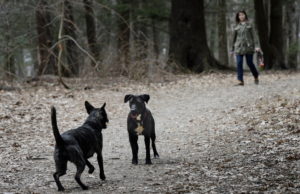
Flagstaff hasn’t gone to the dogs—yet—but large canines on the loose have long spelled bloody carnage
By Mark Cromer
It was an autumn morning I believe, in 1973, and I had just rounded the corner in front of Allison Elementary School in Pomona, California, brown bag lunch in hand and ready for more adventures with Crayons.
It happened extremely fast, but I still remember it in slow-motion, each part playing out like a horror movie edited with bad jump-cuts: the people running, shouting, the torn and bloody clothes on the ground, the single shoe in the street, the cop stepping out of his big black and white radio car and un-holstering his gun, the German shepherd standing his ground and showing his fangs, the crisp ‘pop, pop, pop’ of the gun and then the horrible whelping of the dying dog.
I had just walked into and witnessed the chaotic aftermath of the shepherd’s attacking two other Allison Elementary students who had been walking to school; my friends Jeff and Gerilee, mauling them terribly before the cops arrived.
The dog was not a stray, nor a rabid monster that emerged from some dark alley, but rather the family pet of the home directly across the street from the school’s front office. I knew that family too, my friend Victor’s house. The dog’s final act was to leave a trail of blood as he dragged himself to their doorstep, where he died.
Jeff and Gerilee were rushed to the hospital where they were sewn up and treated for serious wounds all over their bodies.
Such was my first experience with a dog attack.
As Flagstaff now debates the shooting death of Grant Kuenzli, who was killed after three unleashed dogs he had been walking allegedly rushed hiker Harold Fish, I can relate to both sides of the discussion. Flagstaff seems to be a dog-friendly town, with a variety of mutts wandering comfortably in and out of various downtown establishments—something that would trigger mental meltdowns among patrons and business owners in supposedly laid back Southern California.
As the owner of two dogs, Oso Bear, a shepherd/chow mix and Mowgli, a Blue Heeler cattle dog, I love long walks with them through the pleasant streets of Flagstaff’s Cherry Hill neighborhood, where it seems most everyone else has a dog or two as well. Unlike my native Southern California, dog-walking the streets here is generally a much safer bet, in part because Flagstaff isn’t home to 10,000 feral dogs running loose, which is probably a low-end number for SoCal (I’ve read numbers like 50,000, but obviously it is hard to calculate). In the poor and heavily immigrant areas their presence is bountiful and the cops I know refer to them as ‘ghetto elk’ and ‘barrio deer.’
If kids running unattended throughout the streets of Los Angeles by the thousands—and they are—you can imagine how much attention is spent on keeping an eye on dogs. Muy poquito!
Yet even in Flagstaff I have discovered more than a few upper-middle class dog owners who appear to be enjoying an uncut dose of lysergic acid diethylamide when it comes to not leashing their dogs. Indeed, these people are definitely tripping when they allow their dogs to sit untethered in their front yards, apparently placing their faith in a cosmic shield that will prevent Fido & Co. from bolting off the lawn and tearing at my dogs at a blazing fast clip, howling all the way.
What these Captain Cosmos owners seem to be having trouble processing is A) Dogs are animals and even if domesticated can and will attack unexpectedly and B) Unleashed ‘friendly’ dogs rushing other leashed dogs may not equal a friendly encounter. Yet when I offered this observation to one house frau nearby after her giant poodle-looking mutt bolted off her lawn and squared off with my boys, she seemed put off by my ‘attitude.’ I walked away after we separated the dogs, but I must admit I wonder what her thoughts would have been if her dog had attacked my dogs or me? I mean, when the lawyer’s letter arrived, would she get it then?
The details of Grant Kuenzli’s fate may in fact never be known, in part because he’s not around to tell his part of the shooting. There are certainly serious questions raised by Fish’s story, such as: Why did he fire a warning shot at the charging dogs, but not Kuenzli—whom he claimed then attacked him? Why didn’t he take evasive action? Why did he put three rounds into Kuenzli’s chest, instead of firing a single round to stop him?
Having spent about five years assigned to the crime beat in Los Angeles County, I have heard plenty of cops say if you ever have to shoot someone you better have been in reasonable fear for your life—you better be able to establish you had reason to believe your life was truly at risk. An unarmed man gunned down in the forest, well, that may be a tall order to fill.
But what’s tragic about this shooting is that one man is dead, another has been charged with second-degree murder, and a dog leash starts at about six bucks.
[This column was first published in Flagstaff Live! in 2004]











